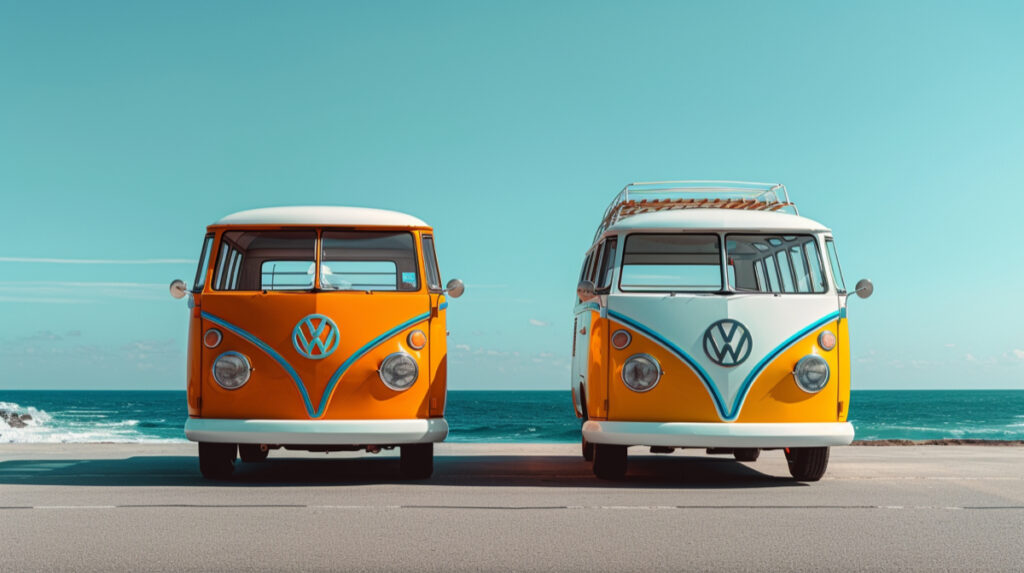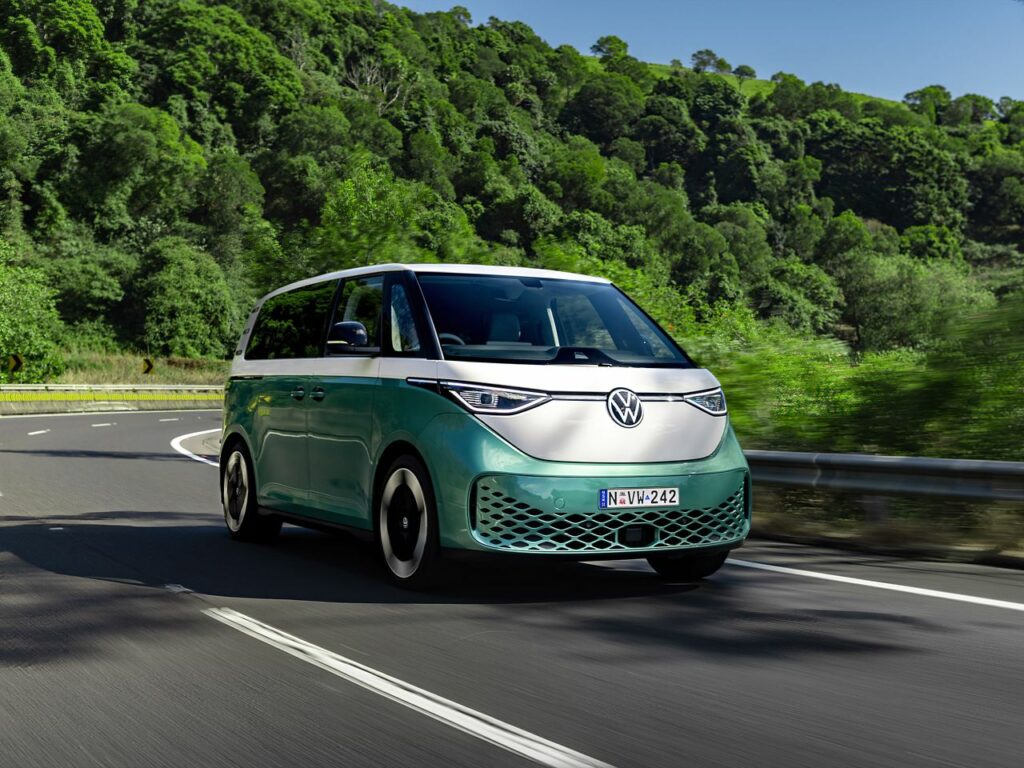The Volkswagen Kombi is more than just a vehicle; it symbolises freedom, adventure, and an enduring legacy in car culture. Since its introduction in the 1950s, the Kombi has captured the hearts of millions worldwide.

Why So Popular?
- Versatility: Whether for family road trips or as a mobile home for adventurous souls, the Kombi’s adaptable design caters to various needs.
- Iconic Design: Its distinct, boxy shape and round headlights make it instantly recognisable.
- Cultural Impact: From surfboards on the roof to flower power paint jobs, the Kombi became a canvas for individual expression.
A Journey Through Time
The Kombi’s history is rich with stories and transformations. Originally launched as the Volkswagen Type 2, it quickly earned nicknames like Transporter, Microbus, and Bulli. Each name reflects a different facet of its multifaceted identity.
“It’s not just a means of transport; it’s a way of life.”
Whether you’re reminiscing about your own adventures or dreaming of new ones, exploring the history of the Volkswagen Kombi offers a fascinating journey through time.
The Early Years: Origins and Design
The Volkswagen Type 2, the Transporter, Microbus, or Bulli, was first introduced in 1950. It was created based on a brilliant idea by Ben Pon, a Dutch Volkswagen importer. In 1947, Pon developed a simple yet groundbreaking concept for a van using the Volkswagen Beetle as a starting point. This concept would later become an iconic symbol in the world of automobiles.
Ben Pon’s goal was to design a practical and versatile vehicle. His sketch depicted a van with a flat front, rear engine placement, and spacious cargo area. This design was revolutionary at the time as it prioritised functionality while maintaining a compact and maneuverable size. Thus, the first generation of the Type 2, also referred to as the T1, was born.

Key Features of the T1:
- Flat Front Design: Allows maximum utilisation of space.
- Rear Engine Placement: Offered improved traction and more room inside.
- Versatility: This could be easily adapted for carrying goods and transporting passengers.
The T1 quickly gained popularity due to its practicality and distinctive look. It wasn’t just a regular van; it made a statement and appealed to various groups in society. Business owners appreciated its reliability for transportation, while families saw it as an opportunity for exciting adventures.
Pon’s innovative approach not only paved the way for Volkswagen’s success in the commercial vehicle market but also laid the foundation for future generations of the Kombi that would continue to captivate people worldwide.
A Look Back: Evolution of the Volkswagen Kombi
T1: The Original Icon
The Volkswagen Kombi, or Type 2, debuted in 1950 and quickly became a beloved classic. This model, also known as the T1, set the standard for what a versatile, reliable van should be. Some key features of the T1 include:
- Distinct Split Windshield: The iconic split windshield gave it a unique look synonymous with vintage charm.
- Rear-Engined Design: Like its predecessor, the VW Beetle, the T1 featured a rear-engine layout, which provided better traction and more interior space.
- Air-Cooled Engine: The air-cooled flat-four engine was simple yet effective, making it easy to maintain and repair.
- Versatile Interior: With multiple seating arrangements and a spacious cargo area, the T1 was perfect for family and commercial trips.
One notable aspect of the T1 is its various forms. From camper vans equipped with pop-top roofs and kitchenettes to basic panel vans for businesses, the T1 truly catered to diverse needs.
T2: A Modern Take on a Classic
In 1967, Volkswagen introduced the T2, marking the second generation of this iconic vehicle. While retaining some elements of its predecessor, the T2 brought several significant changes:
- Single-Piece Windshield: The split windshield was gone, replaced by single-piece curved glass that improved visibility.
- Larger Size: The T2 was slightly larger than the T1, providing more interior space and better comfort.
- Improved Suspension: A new suspension system made for a smoother ride, addressing one of the major complaints about the T1.
- Enhanced Safety Features: Upgraded braking systems and other safety improvements made the T2 more reliable and safer to drive.
Critical Differences Between T1 and T2
While both generations shared core characteristics like the rear-engined layout and air-cooled engines, several distinctions set them apart:
- Design Changes:
- T1: Known for its charming split windshield and smaller size.
- T2: Featured a single-piece windshield and increased dimensions for better comfort.
- Mechanical Upgrades:
- T1: Simple air-cooled engine with basic suspension.
- T2: Enhanced engine options with improved suspension systems for a smoother ride.
- Safety Enhancements:
- T1: Basic safety features typical of vehicles from that era.
- T2: Significant upgrades in braking systems and structural design to meet newer safety standards.
Both generations have their own unique appeal. The T1 is cherished for its classic look and simplicity, while the T2 is appreciated for its enhancements in comfort and safety without losing its original charm.
The evolution from T1 to T2 highlights Volkswagen’s commitment to innovation while staying true to what made the Kombi iconic in the first place.
Cultural Significance: The Volkswagen Kombi and Counterculture Movements
The 1960s was a decade of radical change, and the Volkswagen Kombi became an unexpected symbol of the counterculture movements that defined this era. Often referred to as the “hippie van,” the Kombi captured the spirit of freedom, adventure, and a rejection of mainstream society.
A Vehicle for Change
Various social movements gained momentum during the 1960s. People sought ways to break free from traditional norms, from civil rights to anti-war protests. The Volkswagen Kombi emerged as a vehicle that transported people and carried their ideals.
- Freedom on Wheels: For many, the Kombi represented unbounded freedom. Its spacious interior allowed for modifications, making it perfect for road trips and living on the go. People could travel anywhere, setting up camp whenever and wherever they wanted.
- Adventure Awaits: With its robust design and reliable engineering, the Kombi was ideal for adventurers exploring off-the-beaten-path locations. It became synonymous with road trips and outdoor escapades.
- Rejecting Mainstream Society: Kombi’s utilitarian design contrasted sharply with the flashy cars that were popular then. Owning a Kombi was a statement against consumerism and conventional lifestyles.

Iconic Moments
The Volkswagen Kombi wasn’t just a part of the counterculture; it often was at the centre of crucial historical moments.
“The Kombi is more than just a mode of transportation; it’s a movement.” – Unknown.
- Woodstock 1969: One iconic example is Woodstock, where countless Kombis filled the fields. They served as makeshift homes and gathering spots for festival-goers, encapsulating the essence of community and shared experiences.
- Protest Marches: Kombis transported activists and supplies during various protest marches across America. Their presence became almost symbolic of peaceful resistance.
A Lasting Legacy
The counterculture movements may have peaked in the 1960s, but their impact—and that of the Volkswagen Kombi—endured long after.
- Pop Culture Staple: Films, music videos, and art from subsequent decades often feature the Kombi as shorthand for rebellion and freedom.
- Modern-Day Tributes: Today’s retro-styled products and events frequently draw inspiration from this iconic vehicle, keeping its spirit alive.
The Volkswagen Kombi’s association with ideals like freedom, adventure, and a rejection of mainstream society helped cement its status as an icon during one of history’s most transformative periods. This legacy endures in nostalgia and inspires new generations to seek their own paths to independence.
Global Impact: Competitors, Influences, and Legacy
The Volkswagen Kombi didn’t just carve out its niche without facing stiff competition. Several big names in the automotive world took note and tried to replicate its success.
Competitors
- Ford Econoline: Introduced in 1961, the Ford Econoline was one of the earliest competitors. Unlike the Kombi’s rear-engine design, the Econoline featured a front-engine layout that offered different handling dynamics and cargo space configurations.
- Dodge A100: This compact van, which debuted in 1964 with a unique cab-over design, was often praised for its powerful engine options and versatility.
- Chevrolet Corvair 95 Corvan: Another notable rival was Chevrolet’s Corvair 95 Corvan, launched in 1961. It featured a rear-engine setup like the Kombi but boasted innovations such as a flat floor design, which improved cargo loading.
Influences
The Kombi didn’t just inspire competitors; it also influenced vehicle design globally:
- Citroën H Van: This French classic shared some of the utilitarian spirit of the Kombi. It was introduced in 1947 and featured front-wheel drive and a flat-load floor, making it a favourite among small businesses.
- Renault Estafette: Another French counterpart, the Renault Estafette, came onto the scene in 1959. Its front-wheel-drive layout provided ample cargo space, mirroring some practical aspects that made the Kombi so beloved.
Cultural Legacy
The Volkswagen Kombi’s impact went beyond just being another vehicle on the road. It became a symbol of freedom, mobility, and counterculture. Its spacious interior made it ideal for long road trips and spontaneous adventures, fitting perfectly with the ethos of an era defined by exploration and self-expression.
Iconic imagery from music festivals like Woodstock often shows Kombis parked alongside tents and makeshift stages. These images have become embedded in cultural memory, reinforcing the Kombi’s status as more than just a van but a lifestyle choice.
This vehicle has left an indelible mark in countries around the world, from Brazil to Australia. Its influence can be seen in automotive design and popular culture, appearing in movies, TV shows, and even music album covers.
This timeless appeal resonates today as enthusiasts gather for events celebrating this iconic vehicle. Its legacy is not confined to any single country or culture; it’s a global phenomenon that has inspired countless imitations and tributes over decades.
From Road Trips to Family Adventures: The Versatility of the Volkswagen Kombi
The Volkswagen Kombi is a unique vehicle that can be used for both exciting adventures and comfortable family outings. Its design represents freedom and adaptability, making it a top choice for spontaneous road trips and planned family activities.

Adventure-Ready Design
1. Spacious Interior: The Kombi has plenty of space inside, allowing for easy storage and comfortable seating. The Kombi can handle it all, Whether you’re bringing surfboards for a beach getaway or packing camping equipment for a weekend in the mountains.
2. Durability: The Kombi is built with strong materials to withstand tough terrains and long trips. This makes it perfect for those who love exploring off the usual routes.
Family-Friendly Features
1. Adjustable Seats: One of the standout features of the Kombi is its flexible seating arrangement. This innovation means that seats can be moved around to fit different needs:
- Sleeping Arrangements: Seats can be folded down flat to create a makeshift bed, ideal for overnight stays on the road.
- Dining Setup: The interior can be transformed to include a small table, turning the Kombi into a cozy dining area during breaks.
- Passenger Comfort: Seats can be modified to provide more legroom or to face each other, creating a more social atmosphere during journeys.
2. Safety Features: As families started using the Kombi for their travels, safety became extremely important. The Kombi was equipped with seatbelts and reinforced structures that offered extra protection for everyone on board.
Real-Life Examples
Many families personalised their Kombis to meet their specific requirements. Some added pop-top roofs that expanded living space vertically, while others installed compact kitchens with stoves and sinks.
“Our family spent summers traveling across Europe in our Kombi,” recalls Jane Doe, a long-time owner. “The ability to change the interior layout made every trip feel like an adventure without compromising on comfort.”
Versatility in Every Situation
The Volkswagen Kombi adapted to various situations, contributing significantly to its widespread popularity and lasting reputation. The Kombi could do it all, whether it was being used as a mobile home for long journeys or as a dependable vehicle for everyday commuting.
The adventure-ready features and family-friendly amenities ensured the Volkswagen Kombi remained relevant across generations, appealing to thrill-seekers and those seeking quality time with loved ones.
Looking Ahead: The Revival of a Legend with the Volkswagen ID. Buzz
Enter the Volkswagen ID. Buzz, the modern incarnation of the beloved Microbus. This electric vehicle seamlessly blends nostalgia with cutting-edge technology, reimagining the iconic design for a new generation. With its retro-futuristic look, the ID. Buzz pays homage to its predecessors while embracing the future of automotive innovation.

Key Features of the Volkswagen ID. Buzz
- Electric Powertrain: A fully electric vehicle that offers zero emissions and aligns with global sustainability goals.
- Advanced Technology: Equipped with state-of-the-art driver assistance systems and connectivity options.
- Spacious Interior: Designed to provide ample space and comfort, reminiscent of the original Kombi’s versatile layout.
The ID. Buzz’s impact on today’s automotive landscape is significant. It caters to long-time fans of the original Microbus and new customers looking for eco-friendly options without compromising style or functionality. By combining classic design elements with modern amenities, the ID. Buzz has the potential to lead a new wave in electric vehicle adoption, all while preserving the spirit of adventure that made its forebear so iconic.
The revival of this legend signifies more than just a comeback; it’s a testament to how timeless designs can evolve to meet contemporary needs and shape future trends in mobility.
Preserving History: Car T-Shirts Celebrating the Volkswagen Kombi
Car-themed clothing is more popular than ever, and one car in particular has become a symbol of this trend: the Volkswagen Kombi. T-shirts featuring this iconic vehicle are a big hit among dedicated car lovers and casual fans. They allow you to proudly display your passion for cars through what you wear.
![[object Object]](https://originalrace.com.au/wp-content/uploads/2021/08/combi-white_t-shirt_original_race_australia-585x1024.jpg)
Why You Should Rock Car Enthusiast T-Shirts
Here are a few reasons why these t-shirts are so awesome:
- Nostalgia: Putting on a t-shirt with a vintage Kombi design brings back memories of road trips, family adventures, and the feeling of freedom that comes with them.
- Conversation Starters: Sporting a shirt that showcases your love for cars can easily lead to conversations with other enthusiasts who share your interest in automotive history.
- Versatility: These shirts are perfect for any occasion. Whether you’re getting dressed for a casual day out or getting ready to attend a car meet, they always work.
- Unique Style: Vintage car designs bring a relaxed retro vibe to your wardrobe, helping you stand out while paying tribute to an icon.
Owning one of our car t-shirts isn’t just about following a fashion trend; it’s about expressing your connection to automotive culture. These shirts symbolise pride, celebrating the everlasting appeal of classic vehicles like the Volkswagen Kombi.
In Conclusion
The Volkswagen Kombi has become an integral part of car history, capturing the interest of car lovers worldwide. Its transformation from a practical vehicle to a symbol of culture highlights its everlasting popularity. Whether through sentimental journeys or nonconformity, the Kombi’s impact still holds true, representing independence and excitement. This lasting appeal guarantees that the Kombi remains a cherished classic honored by all generations.
FAQs (Frequently Asked Questions)
What is the Volkswagen Kombi, and why is it considered iconic in car culture?
The Volkswagen Kombi is a historic vehicle that has become an iconic symbol in car culture due to its unique design, versatility, and enduring popularity. It has been celebrated for its role in counterculture movements and association with freedom, adventure, and a rejection of mainstream society.
Who played a significant role in the design and development of the Volkswagen Type 2?
Ben Pon played a crucial role in the design and development of the Volkswagen Type 2, also known as the Transporter, Microbus, or Bulli. His contributions were instrumental in shaping the iconic vehicle, which has left a lasting impact on automotive history.
What are some key differences between the T1 and T2 generations of the Volkswagen Kombi?
The T1 and T2 generations of the Volkswagen Kombi feature distinctive design elements and technological advancements that set them apart. These differences contributed to the vehicle’s evolution over time, making each generation unique in its own right.
How did the Volkswagen Kombi become associated with counterculture movements, particularly in the 1960s?
The Volkswagen Kombi became an icon for counterculture movements in the 1960s due to its embodiment of ideals such as freedom, adventure, and rejecting mainstream society. Its versatile design made it a symbol of unconventional living and travel experiences.
What impact did the Volkswagen Kombi have on similar vehicles globally?
The Volkswagen Kombi had a significant influence on the design of similar vehicles globally, inspiring manufacturers to create their own versions of rear-engined transporters. This cultural legacy can be seen in vehicles like the Citroën H Van, Renault Estafette, and others.
How did the design of the Volkswagen Kombi make it suitable for both adventurous road trips and family outings?
The Volkswagen Kombi’s versatile design makes it suitable for adventurous road trips and comfortable family outings. Unique features such as repositionable seating add to its versatility, making it a popular choice for various types of journeys.
What is the Volkswagen ID? What impact is it expected to have in the current automotive landscape?
The Volkswagen ID. Buzz is the modern incarnation of the Microbus, combining nostalgia with cutting-edge electric technology. It is expected to significantly impact the current automotive landscape by offering a blend of classic design appeal with environmentally friendly electric power.
Why are car enthusiasts’ t-shirts featuring classic vehicles like the Volkswagen Kombi popular among automotive enthusiasts?
Car enthusiast t-shirts featuring classic vehicles like the Volkswagen Kombi are popular among enthusiasts because they allow individuals to express their passion for automotive history. These shirts celebrate iconic vehicles while showcasing one’s love for cars and car culture.
What is the enduring legacy of the Volkswagen Kombi, and why does it hold timeless appeal to car enthusiasts worldwide?
The Volkswagen Kombi’s enduring legacy lies in its timeless appeal to car enthusiasts worldwide. Its iconic status, cultural significance, and versatile design have cemented its place in automotive history, making it a beloved symbol of freedom, adventure, and individuality.


